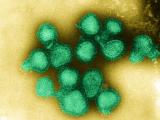Jun 7, 2010 (CIDRAP News) – Little is known about the safety and efficacy of oseltamivir (Tamiflu) in infants, but German researchers who reviewed cases of babies hospitalized with influenza found the drug yielded benefits similar to those in older children, though mild gastrointestinal symptoms were more common.
The retrospective review of 157 babies who were hospitalized with seasonal influenza infections at a German teaching hospital covers five flu seasons, from 2003 through 2007. The findings appear in the June issue of Pediatric Infectious Disease Journal.
In the United States, oseltamivir is not approved for use in babies younger than 1 year, but because of the H1N1 flu pandemic, in September 2009 the US Food and Drug Administration approved an Emergency Use Authorization for the drug for this age-group. The FDA approved the drug for treatment but advised clinicians not to use it prophylactically in infants younger than 3 months unless they have significant flu exposure and a high risk of severe illness.
The federal declaration of a public health emergency allowed the FDA to issue the EUA, which will expire when officials terminate the health emergency, unless the agency revokes it first under terms of the Federal Food, Drug, and Cosmetic Act.
All infants in the study group had flu confirmed by rapid influenza testing. According to the hospital's treatment policy, all of the children received oseltamivir within 48 hours after symptom onset. They received the drug, 2 mg/kg per body weight, twice a day for 5 days.
Only one baby, who stopped treatment after repeated vomiting, did not complete the 5-day treatment course. Symptoms not seen on hospital admission were noted in half of the infants, which included vomiting and mild diarrhea. Gastrointestinal infections such as rotavirus were seen in 11 infants.
About 90% of the patients received oseltamivir within 24 hours of symptom onset. Body temperature decreased to or below 100.4 degrees F within 36 hours of treatment initiation in 82% of the study group. In eight patients, body temperature dropped within 48 hours.
In light of limited experience with the drug in babies, the researchers said the findings illuminate the usefulness of the drug in the vulnerable age-group, particularly since the youngest infants cannot receive the seasonal flu vaccine.
The authors noted that the findings were comparable to studies of oseltamivir use in children older than 1 year. For example, they said an earlier study of 695 children showed that vomiting was the only adverse effect seen more often than with placebo.
The investigators did not find a greater risk of central nervous system disorders, a problem that some Japanese studies have suggested.
In their assessment of efficacy, the group wrote that though the study lacked a control group, the resolution of patients' fever is consistent with trials in children older than 1. They said their findings suggest that osteltamivir is as safe and effective as in older children, though more prospective, controlled studies should be done to confirm the results.
Siedler K, Skopnik H. Oseltamivir for treatment of influenza in infants less than one year: a retrospective analysis. Ped Infect Dis J 2010 Jun;29(6):495-98 [Abstract]
See also:
FDA statement on EUA for oseltamivir in infants
FDA background information on oseltamivir EUA




















